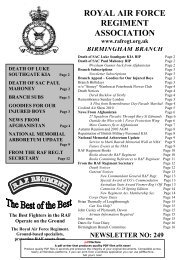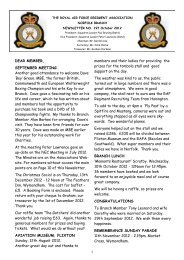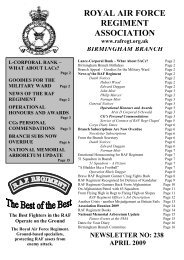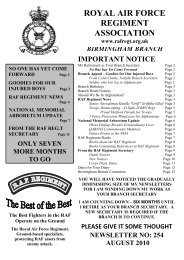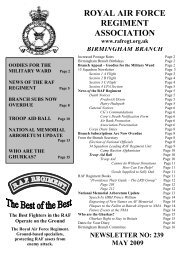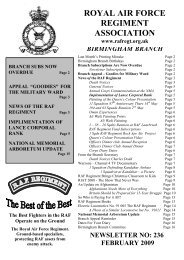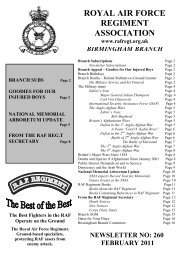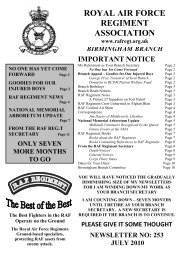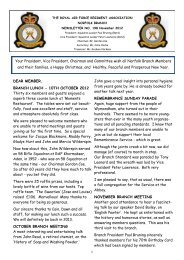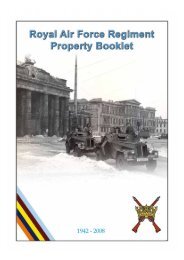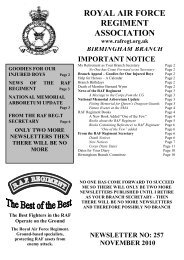September 2010 - RAF Regiment Association Official Website
September 2010 - RAF Regiment Association Official Website
September 2010 - RAF Regiment Association Official Website
You also want an ePaper? Increase the reach of your titles
YUMPU automatically turns print PDFs into web optimized ePapers that Google loves.
3<br />
You will all by now have with your latest<br />
copy of “The Flash”, received a booking form<br />
and with its superb location and military<br />
connections it is sure to be a great hit so get your<br />
bookings in early. This majestic Grade II castle<br />
with spectacular views of the North Wales<br />
coastline is home to the National Portrait<br />
Gallery’s Victorian Collection. It is set amid<br />
beautiful woodlands and sensory gardens, less<br />
than an hour from the Snowdonia National Park.<br />
With its magnificent views stretching to<br />
the Clwydian Hills and its feast of live<br />
entertainment on offer, this is a hotel where you<br />
can really spoil yourself. Outside, the beautifullytended<br />
grounds include a maze, an aviary and a<br />
tranquil woodland walk.<br />
The scenery could best be described as<br />
magnificent and dramatic. It is just under an hour<br />
from Chester, 10 minutes from the seaside town<br />
of Rhyl, and half an hour away from the Victorian<br />
Pier at Llandudno. As well as being a historic<br />
house and museum with a free audio tour<br />
available, the Castle also boasts large areas of<br />
formal garden and natural woodland.<br />
A particular feature is the area of practice<br />
trenches dating from the First World War. In<br />
1914, the house that a century earlier had been<br />
designed to look like a castle was requisitioned by<br />
the army for nearby Kinmel Barracks.<br />
Within the grounds, there is a reminder of<br />
the Great War years. Training was an important<br />
activity during the First World War (1914-1918).<br />
It helped to prepare newly recruited soldiers many<br />
of whom had never considered the intricacies of<br />
'modern' warfare. The local training camp for the<br />
area was Kinmel Park Camp, which is located not<br />
too far from the Castle. The camp has operated<br />
for many years but is remembered by many as the<br />
camp where the infamous riots took place after the<br />
First World War.<br />
The training trenches are located in the<br />
Bodelwyddan Castle Parkland. A set of<br />
interpretive panels will be available shortly that<br />
will provide information on what it was like to be<br />
a soldier living, fighting and dying in the trenches<br />
and illustrations of how the trenches were<br />
constructed.<br />
BELTON PARK<br />
Now for a couple of reports from Hughie<br />
Cooper the Branch Research Co-ordinator who<br />
visited the site of the first <strong>RAF</strong> <strong>Regiment</strong> Depot<br />
Belton Park, Lincolnshire and on the following<br />
day visited the NMA.<br />
At the beginning of World War I, like<br />
many other British landowners, the 3rd Earl<br />
Brownlow offered his house and park to the<br />
Government for war service. The offer was<br />
accepted, and in 1915, the home depôt and<br />
training ground of the Machine Gun Corps were<br />
established in the southern part of Belton Park.<br />
The lie of the land there, where the River<br />
Witham passes between the Lower Lincolnshire<br />
Limestone and the Upper Lias mudstone, lent<br />
itself to the development of the necessary firing<br />
ranges close to good communications by way of<br />
the Great North Road and the East Coast main<br />
line railway station at Grantham.<br />
The depôt was closed in 1919, the site<br />
cleared and the land restored to Lord Brownlow in<br />
1920. Little sign of the Machine Gun Corps's stay<br />
remains in the park, but plaques and inscriptions<br />
can be followed from the south gate of Belton<br />
park to the memorial gate on the way from there<br />
to the town centre and in the north aisle of<br />
Grantham parish church.<br />
Belton Park again saw war service during<br />
World War II.<br />
On the formation of the <strong>RAF</strong><br />
<strong>Regiment</strong> in 1942 the park became the first home<br />
of the <strong>Regiment</strong>, when soon afterwards it moved<br />
to Belton where it was housed in nissen huts in<br />
the park. In January 1984 as a result of death<br />
duties, coupled with the rising costs of the<br />
upkeep, made Belton too much for the Brownlow<br />
family and ownership of the house, garden and<br />
some of the contents was transferred to the<br />
National Trust.<br />
OUR VISIT TO BELTON PARK<br />
14 th August <strong>2010</strong><br />
By Hughie Cooper<br />
When I first heard about this event we<br />
decided to go and at the same time, as they lived<br />
in the same area, meet two of my brothers. When<br />
we were discussing the visit, one of them said that<br />
they could do with some rain in Lincolnshire as in<br />
July; they had only had 5 mm of rain whereas in<br />
other areas they had 134 mm.<br />
I told them their worries were over as the<br />
<strong>RAF</strong> <strong>Regiment</strong> would solve their problem, for in<br />
my experience at various <strong>Regiment</strong> functions,<br />
particularly ceremonial events, it always seemed<br />
to rain. Were therefore arranged to meet at<br />
Sleaford and then travel down to Belton Park for<br />
the Saturday and Saturday if weather permitted,



